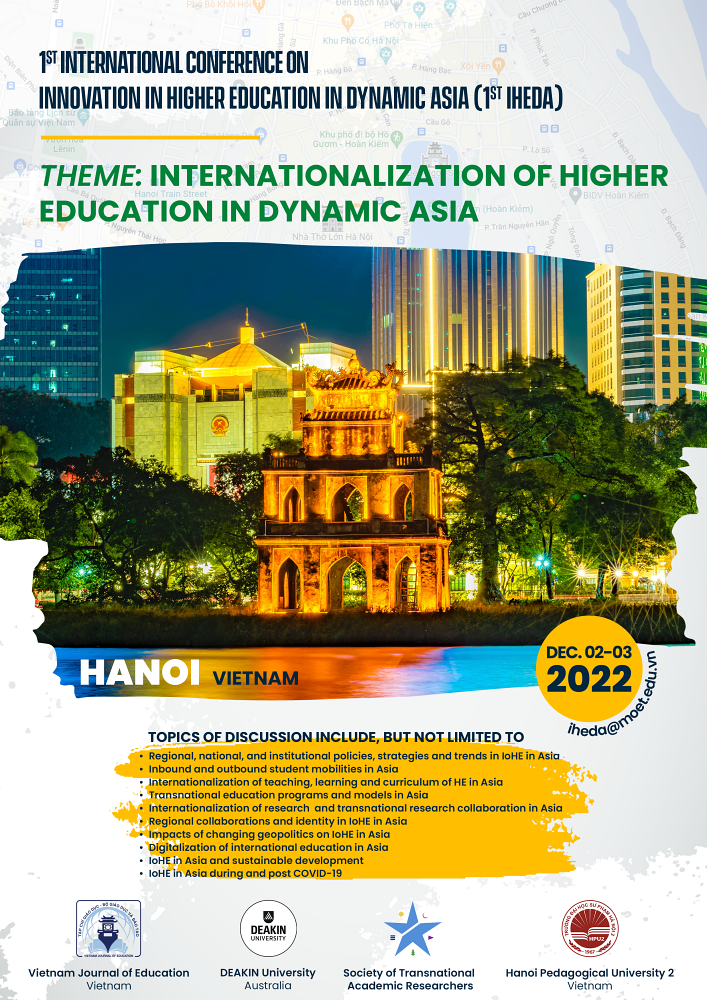Text mining in the trend of education 4.0: A study on clustering mathematical terms of algebra textbooks in Vietnamese high schools
DOI:
https://doi.org/10.52296/vje.2020.81-
Downloads
How to Cite
Abstract
In the context of Educational Revolution 4.0, text mining with digital tools plays an important role. Various techniques and softwares have been employed in text mining, among which the clustering technique using Atlas.ti, a German software, is widely used thanks to its versatility and open access. This article presents the results of clustering Mathematical terms in Algebra textbook in Vietnamese high schools with the support of Atlas.ti. Initial research results can yield the insight into the relationship among Mathematical terms in the curriculum, thereby, aiming for a better teaching process.
Downloads
References
Barry, C. A. (1998). Choosing qualitative data analysis software: Atlas.ti and Nudist compared. Sociological research online, 3(3), 16-28.
Camillo, F., Tosi, M., & Traldi, T. (2005). Semiometric approach, qualitative research and text mining techniques for modeling the material culture of happiness. Berlin, Germany: Springer.
Chall, J. S. (1997). An analysis of textbooks in relation to declining SAT scores.
Crawford, I., Ruske, S., Topping, D. O., & Gallagher, M. W. (2015). Evaluation of hierarchical agglomerative cluster analysis methods for discrimination of primary biological aerosol. Atmospheric Measurement Techniques, 8(11), 4979.
Decherchi, S., Tacconi, S., Redi, J., Leoncini, A., Sangiacomo, F., & Zunino, R. (2009). Text clustering for digital forensics analysis. In Computational Intelligence in Security for Information Systems (pp. 29-36). Springer, Berlin, Heidelberg.
Gaikwad, S. V., Chaugule, A., & Patil, P. (2014). Text mining methods and techniques. International Journal of Computer Applications, 85(17).
Gibbs, G. R., Friese, S., & Mangabeira, W. C. (2002). The use of new technology in qualitative research. Introduction to Issue 3(2) of FQS. In Forum Qualitative Sozialforschung/Forum: Qualitative Social Research (2002).
Gupta, V., & Lehal, G. S. (2009). A survey of text mining techniques and applications. Journal of emerging technologies in web intelligence, 1(1), 60-76.
Hearst, M. (2003). What is text mining. SIMS, UC Berkeley.
Hong, C. F. (2009). Qualitative chance discovery - Extracting competitive advantages. Information Sciences, 179, 1570-1583.
Hwang, S. (2008). Utilizing qualitative data analysis software: A review of Atlas.ti. Social Science Computer Review, 26(4), 519-527.
Irfan, R., King, C. K., Grages, D., Ewen, S., Khan, S. U., Madani, S. A., … & Tziritas, N. (2015). A survey on text mining in social networks. The Knowledge Engineering R.
Ivić, I., Pešikan, A., & Antić, S. (2013). Textbook Quality. A Guide to Textbook Standards. Göttingen: V&R Unipress.
Jalali, S. M. J., Park, H. W., Vanani, I. R., & Pho, K. H. (2020). Research trends on big data domain using text mining algorithms. Digital Scholarship in the Humanities.
Janasik, N., Honkela, T., & Bruun, H. (2009). Text mining in qualitative research: Application of an unsupervised learning method. Organizational Research Methods, 12(3), 436-460.
Konopásek, Z. (2007). Making thinking visible with Atlas. ti: Computer-assisted qualitative analysis as textual practices. Historical Social Research/Historische Sozialforschung. Supplement, 276-298.
Korhonen, A., Silins, I., Sun, L., & Stenius, U. (2009). The first step in the development of text mining technology for cancer risk assessment: identifying and organizing scientific evidence in risk assessment literature. BMC bioinformatics, 10(1), 303.
Krippendorff, K. (2004). Content analysis: An introduction to its methodology. Thousand Oaks, CA: Sage Publications.
Lau, K. H., Lam, T., Kam, B. H., Nkhoma, M., Richardson, J., & Thomas, S. (2018). The role of textbook learning resources in e-learning: A taxonomic study. Computers & Education, 118, 10-24.
Lebrun, J., Lenoir, Y., Laforest, M., Larose, F., Roy, G. R., Spallanzani, C., & Pearson, M. (2002). Past and current trends in the analysis of textbooks in a Quebec context. Curriculum Inquiry, 32(1), 51-83.
Mahmoudi, M. R., & Abbasalizadeh, A. (2019). How statistics and text mining can be applied to literary studies?. Digital Scholarship in the Humanities, 34(3), 536-541.
Ministry of Education and Training (2017). High School Education Program. Retrieved from https://moet.gov.vn
Muhr, T. (1991). ATLAS/ti-A prototype for the support of text interpretation. Qualitative Sociology, 14(4), 349-371.
Okeeffe, L. (2013). A framework for textbook analysis. International Review of Contemporary Learning Research, 2(1), 1-13. http://dx.doi.org/10.12785/irclr/020101
Rajman, M., & Besançon, R. (1998). Text mining: natural language techniques and text mining applications. In Data mining and reverse engineering (pp. 50-64). Springer, Boston, MA.
Rose, J., & Lennerholt, C. (2017). Low-cost text mining as a strategy for qualitative researchers. Electronic Journal of Business Research Methods, 15(1), 2-16.
Salloum, S. A., Al-Emran, M., Monem, A. A., & Shaalan, K. (2018). Using text mining techniques for extracting information from research articles. In Intelligent natural language processing: Trends and Applications (pp. 373-397). Springer, Cham.
Silver, C., & Lewins, A. (2014). Using software in qualitative research: A step-by-step guide. Sage.
The Prime Minister (2019). Decision on approving the project “Teaching and learning foreign languages in the national education system in the 2008-2020 period”. Accessed from http://vanban.chinhphu.vn
Tian, Y., & Pho, K. H. (2019). A statistical view to study the aphorisms in Nahj al-Balaghah. Digital Scholarship in the Humanities.
Tuan, B. A., Pudikova, G. N., Mahmoudi, M. R., & Pho, K. H. (2019). Statistical approaches in literature: Comparing and clustering the alternatives of love in Divan of Hafiz. Digital Scholarship in the Humanities.
Tummons, J. (2014). Professional standards in teacher education: tracing discourses of professionalism through the analysis of textbooks. Research in Post-Compulsory Education, 19(4), 417-432.
Wang, Y., Garjami, J., Tsvetkova, M., Huu Hau, N., & Pho, K. H. (2020). Statistical approaches in literature: An application of principal component analysis and factor analysis to analyze the different arrangements about the Quran’s Suras. Digital Scholarship in the Humanities.
Witten, I. H., Don, K. J., Dewsnip, M., & Tablan, V. (2004). Text mining in a digital library.
Yu, C. H., Jannasch-Pennell, A., & DiGangi, S. (2011). Compatibility between text mining and qualitative research in the perspectives of grounded theory, content analysis, and reliability. The Qualitative Report, 16(3), 730-744.




















